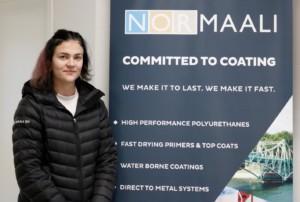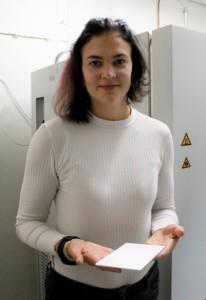7/6/2022
Nor-Maali´s Coating Advisor Sara Grundsten-Lyapova studied alongside her job and graduated with a degree in construction engineering last December. She wrote her thesis, The Use of Water Based Paints in Industrial Painting and Marine Painting, for Nor-Maali.
Sara has been worked as a Coating Advisor at Nor-Maali since January 2020. She works mainly at the Meyer shipyard in Turku, where she provides technical support for the luxury cruise ships being built there. Her main task in technical support is to help the customer achieve the set quality requirements. Achieving the goal can be e.g. training of painters, measurement of paint film thicknesses or inspection of pre-treatment. Sara previously worked as an industrial painter, but then she started to work as a coating advisor, first with a contractor and later in the Technical Service of Nor-Maali.
Sara wanted to develop her professional skills and started to study alongside her job. After couple years of hard work, she graduated as a construction engineer from Turku University of Applied Sciences in December 2021. Sara is planning to to continue in Master´s Programme in industrial engineering and management. “I want to continue my studies as I believe that a higher level education is a critical factor in career advancement. In addition to keep my professional skills up to date, learning new also advances my ability to look things from multiple perspectives”, says Sara.
Sara wanted to do her thesis on some topic related to her work. Nor-Maali offered her a research topic in water-borne coatings, focus on the use and application in industrial painting. Before her thesis, Sara already had a good sense of water-borne coatings through the products used at the shipyard. She had a growing interest there in developing and expanding her knowledge of the wider use of water-borne coatings.

Nor-Maali’s Sara Grundsten-Lyapova wrote her bachelor’s thesis on water-borne industrial coatings.
Sara’s thesis is titled “The Use of Water Based Paints in Industrial Painting and Marine Painting”. The aim of the thesis was to create a comprehensive information package for the user about the general and special features of this topic, which, taking into account the reader, can develop their own activities in an increasingly environmentally friendly direction.
The thesis was divided into two different parts, the theoretical and experimental parts. The theoretical part focused on on water-borne industrial coatings, first in general, then Nor-Maali’s own products. In addition, the thesis examined the storage and transport of products, painting facilities and equipment, and the recycling of waste from the use of water-borne coatings.
In the theoretical part, the differences between water-borne and solvent-based products, for example in terms of health and the environment, and in practical painting work were reviewed. If the user is planning to switch from solvent-based coatings to water-borne products, this comprehensive information package on water-borne coatings and their use and required conditions can facilitate the decision-making process.
Determining the environmental conditions for paint shop and drying facilities is very important, as painting work may fail under unsuitable conditions. The technical properties of the coating can also be impaired.
The experimental part of the thesis consisted of determining limits and optimal values for environmental conditions (ventilation, temperature, relative humidity) during painting and drying of water-borne coatings. Drying times for three Nor-Maali´s water-borne coatings, Akvanor 100 SG (acrylic coating), Normadur Aqua DTM (polyurethane coating) and Norepox Aqua DTM (epoxy coating), were measured in different environmental conditions. The aim of the tests was to find indicative as well as optimal environmental condition values within which the water-borne coatings would be safe to use and drying would be efficient.
The drying time of the Akvanor 100 SG was tested in an air-conditioned paint chamber with three different amount of airflow: 7,500 m3/h, 4,860 m3/h and 1,116 m3/h. The temperature in the painting room was 23 °C. The drying time of the product was extended as the airflow was reduced.
Table 1. Effect of airflow rate on drying time of Akvanor 100 SG.
| Temperature (°C) | Airflow (m3/h) | Drying time (h) |
| 23 | 7500 | 1 |
| 23 | 4860 | 3 |
| 23 | 1116 | 5 |
Drying time tests were continued in a climatic chamber by varying the temperature from 23 to 50 °C and relative humidity from 45 to 70 %. The coating dried faster at higher temperatures (40-50 °C). At a relative humidity of 70 %, the drying of the coating slowed down significantly (over 24 h).
Table 2. Effect of temperature and relative humidity on the drying time of Akvanor 100 SG.
| Temperature (°C) | Relative humidity (%) | Drying time (h) |
| 23 | 45 | 4 |
| 23 | 60 | 6 |
| 23 | 70 | > 24 |
| 40 | 45 | 1 |
| 50 | 45 | 1 |
| 50 | 60 | 1 |
The conclusion from the test was that Akvanor 100 SG would benefit from increasing the temperature to a certain point. The maximum temperature for the painting and drying conditions were defined as 50 °C. Increasing the temperature above 50 °C did not benefit the drying of the coating. The maximum value for relative humidity was defined as 60 %. The optimum temperature was found to be 23 °C and the relative humidity 45 %. Akvanor 100 SG needs good ventilation to dry, higher temperature does not bring significant benefit.
The drying time of the Normadur Aqua DTM was tested in an air-conditioned paint chamber with three different amount of airflow: 7,500 m3/h, 4,860 m3/h and 1,116 m3/h. The temperature in the painting room was 23 °C. Increasing the airflow did not significantly accelerate the drying, with the maximum ventilation the coating dried in eight hours and when the ventilation was reduced it took more than 12 hours to dry.
Table 3. Effect of airflow rate on drying time of Normadur Aqua DTM.
| Temperature (°C) | Airflow (m3/h) | Drying time (h) |
| 23 | 7500 | 8 |
| 23 | 4860 | > 12 |
| 23 | 1116 | > 12 |
In the climatic chamber test, the temperature was varied between 23-80 °C and the relative humidity between 45-70 %. Increasing the temperature from 23 °C to 60 °C significantly accelerated drying. The paint surface began to blister at a relative humidity of 70 %.
Table 4. Effect of temperature and relative humidity on the drying time of Normadur Aqua DTM.
| Temperature (°C) | Relative humidity (%) | Drying time (h) |
| 23 | 45 | 8 |
| 30 | 60 | 3 |
| 30 | 70 | 4 |
| 40 | 45 | 3 |
| 50 | 45 | 2 |
| 60 | 45 | 1 |
| 80 | 45 | 1 |
| 80 | 60 | 1 |
Normadur Aqua DTM was considered to be quite sensitive to variations in environmental conditions. The maximum temperature was defined as 80 °C and the optimum temperature above 30 °C. The maximum relative humidity was defined as 60 % and the optimum value of 45 %.
When using higher temperatures during drying, the product to be painted should be transferred to room temperature after 1-2 hours of heating. The paint surface hardens faster at room temperature.
The drying time of the Norepox Aqua DTM was tested in an air-conditioned paint chamber with three different amount of airflow: 7,500 m3/h, 4,860 m3/h and 1,116 m3/h. The temperature in the painting room was 23 °C. The drying time of the product was extended as the airflow was reduced.
Table 5. Effect of airflow rate on drying time of Norepox Aqua DTM.
| Temperature (°C) | Airflow (m3/h) | Drying time (h) |
| 23 | 7500 | 4 |
| 23 | 4860 | 6 |
| 23 | 1116 | > 12 |
In the climatic chamber test, the temperature was varied between 23-80 °C and the relative humidity between 45-70 %. Norepox Aqua DTM benefited from raising the temperature to 40 °C, increasing it up did not make a significant difference in drying time. At high relative humidity (70 %) and low temperatures (30 °C), the coating dried slowly. At 60 °C, high humidity did not cause a corresponding slowing in drying.
Table 6. Effect of temperature and relative humidity on the drying time of Norepox Aqua DTM.
| Temperature (°C) | Relative humidity (%) | Drying time (h) |
| 23 | 45 | 4 |
| 30 | 70 | 7,5 |
| 40 | 45 | 1,5 |
| 50 | 45 | 1,5 |
| 60 | 45 | 1 |
| 60 | 60 | 1 |
| 60 | 70 | 1 |
| 80 | 45 | 1 |
| 80 | 60 | 1 |
The maximum temperature was set at 80 °C, as the higher temperature was not found to add more value to drying. The optimum temperature was found to be 60 °C, the paint surface dried effectively regardless of the high relative humidity. The maximum value for relative humidity was set at 70 % and the optimum value at 45 % if the air temperature is below 30 °C. When the air temperature is above 30 °C, it is sufficient that the relative humidity is less than 70 %.
It is recommended to bring the painted part to room temperature after 1 to 4 hours, depending on the drying temperature, in which case the coating hardens to dry to handle effectively.
As a result, the importance of the right kind of conditions during both painting and drying was observed in the experimental part.
The parameter that most influenced the final result varied according to the paint type. Based on the results, it makes sense for companies that use water-borne coatings to invest in painting facilities where the amount of airflow, temperature, and relative humidity can be controlled.
Some of the information obtained from the thesis was added to the technical data sheets. In addition, separate Application Guides were created for the products, which provide more detailed information on the use of the product compared to TDS.
Link to Sara’s thesis “The Use of Water Based Paints in Industrial Painting and Marine Painting”: https://www.theseus.fi/handle/10024/512636 (in Finnish)

Sara with Norepox Aqua DTM test panel after the drying time test.
Read more about Sara´s job in Nor-Maali: Nor-Maali Oy delivered steel surface coatings together with technical support and inspection to the luxury cruise ship Costa Toscana